International Journal of Business Research and Management
OPEN ACCESS | Volume 3 - Issue 2 - 2025
ISSN No: 3065-6753 | Journal DOI: 10.61148/3065-6753/IJBRM
Agim BERISHA
Business College, Faculty of Economics.
*Corresponding author: Agim BERISHA, Business College, Faculty of Economics.
Received: May 19, 2025
Accepted: May 20, 2025
Published: June 03, 2025
Citation: Agim BERISHA, (2025). ‘Inflation And the Impact on The Economy- The Case of Kosovo”. International Journal of Business Research and Management 2(5); DOI: 10.61148/3065-6753/IJBRM/048.
Copyright: © 2025. Agim BERISHA, This is an open access article distributed under the Creative Commons Attribution License, which permits unrestricted use, distribution, and reproduction in any medium, provided the original work is properly cited.
The paper deals with inflation, including the impact of inflation on the economy and in the countries of the Western Balkans. An important indicator in the economy of a country is inflation. The Covid19 pandemic, among other things, has also affected the economic processes in different countries of the world, as well as has an impact and effects on the economic processes in Kosovo. Alongside inflation or the indicator that measures the cost of living, in this context, the consumer price index is used to monitor changes in the cost of living over time. The main goal consists in the analysis of the progress of inflation in the economy in Kosovo and in the countries of the Western Balkans. So the purpose of the consumer price index is to measure changes in the cost of living. In the framework of this study, to achieve the objectives, the analysis method, tabular and graphic separately, comparative methods are used, analyzing the dynamics of the issue related to inflation and the impact on the cost of living. Through this study, we consider that the results and recommendations given be taken into account by the relevant institutions.
1.Introduction
Inflation constitutes a macroeconomic disease and is considered a worrying problem for the economy as a whole and for firms and consumers in particular. One of the most well-known indicators and which is followed with interest by all economic entities is inflation. Inflation is a serious problem that negatively affects both the reproduction process and the social stability of the country.
In contemporary economic literature, by inflation we understand the increase in prices or the deflator of the gross domestic product (GDP), or rather the devaluation of the value of local money. Inflation is generally defined as a continuous increase in the average price level of goods and services (Salko& Dhuci, (2005) Tirana). Inflation is the increase in the general level of prices (Koka, (2014). Macroeconomics, Tirana). Inflation represents the continuous increase in the general level of prices (Limani, (2013). Macroeconomics). Inflation mostly hits the poor and low-income strata of the population. This is because inflation represents a continuous process of increasing prices, namely a permanent decrease in the value of money and the purchasing power of the population. Another definition says: "Inflation is a permanent increase in the general level of prices and that at the level proportional to the increase in the general level of prices in certain units of time" (David Begg, Stanley Fischer & Rodiger Dornbasch, (2000). Ekonomics).
In the framework of the study, the main objective is to analyze inflation and the impact on the economy in the Republic of Kosovo and in the countries of the Western Balkans.
Research questions of the paper:
The study is structured as follows. Section 1 presents the introduction, including the main purpose of the paper and the research questions. In section 2, the literature review is presented. Section 3 demonstrates the methodology and methods. Section 4 of the paper gives the result and discussion. Section 5 includes the conclusion of the study.
2.Literature Review
Consumption is the total amount of expenses made by households and individuals for goods and services of the country. For any country, consumption is the largest component of GDP. Statistics show that poor families spend most of their income on essential goods such as food and shelter. Consumption represents consumer spending on goods and services from which benefits are derived in the current period (Koka, (2014). Macroeconomics, Tirana). Consumption is spending on goods and services by households (Mankiw & Taylor, (2012). Ekonomiksi/Macroeconomics).
The consumer price index (CPI) is the indicator most widely used to measure inflation (Berisha. Agim, (2022). Finances, Prishtina). The consumer price index is the most widely known price index. It measures the change over time in the prices of goods and services included in the market basket (Salko & Dhuci, (2005). Money and financiar institucions, Tirana). The CPI measures the cost of a market basket of goods and services consumed by a typical citizen household over a given period of time. The consumer price index (CPI) is an indicator of the overall cost of goods and services purchased by a typical consumer. The consumer price index (CPI) is an indicator of the overall cost of goods and services purchased by a typical consumer (Mankiw & Taylor, (2012). Ekonomiksi/Macroeconomics).
In the calculation of the CPI, the specific weight of each product or service in the consumer's budget is taken into account. The purpose of the consumer price index is to measure changes in the cost of living. In other words, the consumer price index tries to measure how much income must rise in order to maintain an unchanged standard of living.
3. Research methodology
For the finalization of this paper, the material presented has support including scientific literature, as well as reports and publications from the Kosovo Statistics Agency, which deal with issues related to inflation and the impact on the economy and the cost of living in Kosovo. The local statistical source, analysis and synthesis method, tabular and graphic separately, comparative method, etc. were also used.
4.Results and discussions
The consumer price index (CPI) is the most well-known price index. It measures the change over time in the prices of goods and services included in the market basket. The purpose of the consumer price index is to measure changes in the cost of living (Berisha. Agim, (2022). Finances, Prishtina). The consumer price index (CPI) measures the total cost of the market basket. Eurostat has defined the HICP as the European standard for consumer price indices (Kosovo Statistics Agency, (2022). Harmonized Index of Consumer Prices, Pristina, January, 2025). In Kosovo, the Consumer Price Index (CPI), namely the Harmonized Index of Consumer Prices (CPI) is used as the official measure of inflation. The Consumer Price Index (CPI), namely the Harmonized Index of Consumer Prices (CPI) has been published as an annual average index starting in 2002. The consumer price index and the harmonized consumer price index are calculated on the basis of a COICOP classification structure (Classification of Individual Consumption by Purpose), fully compatible with the expenditure structure used by Eurostat (Kosovo Statistics Agency, (2021). The statistical yearbook of Kosovo 2021, Prishtina). Based on this classification, expenses are classified into 12 main groups as (Kosovo Statistics Agency, (2021). The statistical yearbook of Kosovo 2021, Prishtina):
Eurostat has defined the HICP as the European standard for consumer price indices. Data on the prices of the most representative goods and services are collected through the consumer price index questionnaire and the harmonized consumer price index by the staff of the regional offices in the main centers of the country: Gjakova, Gjilan, Mitrovica, Peja, Prizren, Pristina and Ferizaj. 415 products over 6800 prices are monitored in supermarkets, service establishments, shops, markets and other retail outlets.
Table 1: Consumer price index in the period 2015-2024
|
Years |
Average annual price index (2015=100) |
Annual change in % |
|
2015 |
100.0 |
-0.5 |
|
2016 |
100.3 |
0.3 |
|
2017 |
101.8 |
1.5 |
|
2018 |
102.8 |
1.1 |
|
2019 |
105.6 |
2.7 |
|
2020 |
105.8 |
0.2 |
|
2021 |
109.3 |
3.4 |
|
2022 |
122.0 |
11.6 |
|
2023 |
128.0 |
4.9 |
|
2024 |
130.1 |
1.6 |
Source: Kosovo Statistics Agency, Harmonized Index of Consumer Prices, Pristina, January, 2025, pg.5-7.
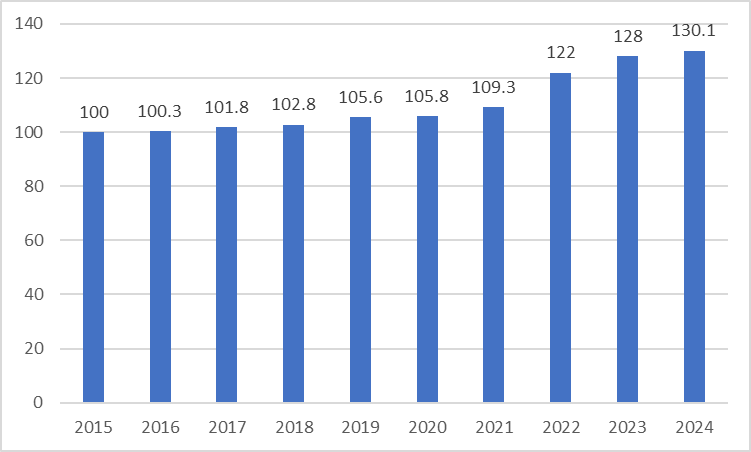
Figure 1: Harmonized annual index of consumer prices according to the years 2015-2024
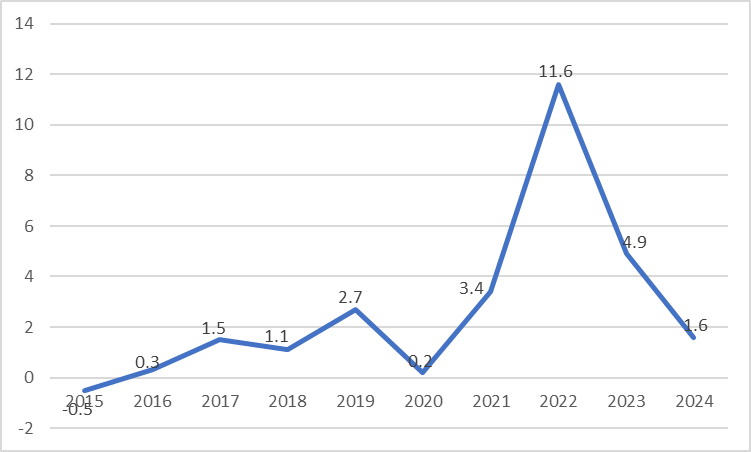
Figure 2: Average annual inflation rates measured by IHÇK for the period 2015-2024
From the table and graph, it can be seen that the average annual inflation rate during the period 2015-2024 had an increasing trend, only the most pronounced increase trend is observed in 2024. So the inflation rate in 2015 was -0.5% compared to the previous year, while in 2016 the inflation rate was 0.3%, in 2017 it was 1.5%, in 2018 it was 1.1%, in 2019 it was 2.7%, with a downward trend in 2020 at the time of the Covid19 pandemic, where the inflation rate was 0.2%, while there was a growth progress in 2021 to 3.4%, especially in 2022 the inflation rate reaches 11.6%, while in 2023 it was 4.9% and in 2024 1.6%.
The following table shows monthly and annual price changes for groups and subgroups of consumer goods and services.
Table 2: Weights, IHÇK for the month of December 2024 (2015=100), monthly and annual price changes for groups and subgroups according to COICOP-in percentage
|
XII-2024 2015=100 |
XII-2024 XI-2024 |
XII-2024 XII-2023 |
Average annual index 2024 2015=100 |
2024 2023 |
|
|
Total IHÇK |
131.2 |
0.7 |
1.1 |
130.1 |
1.6 |
|
Food and soft drinks |
148.2 |
0.7 |
3.5 |
145.3 |
2.2 |
|
- Food |
149.7 |
0.7 |
2.4 |
147.4 |
1.4 |
|
-Non-alcoholic drinks |
139.2 |
0.7 |
8.5 |
133.8 |
6.2 |
|
Alcoholic beverages and tobacco |
141.7 |
-0.3 |
2.1 |
140.7 |
4.1 |
|
Clothing and shoes |
109.8 |
0.2 |
2.2 |
108.8 |
2.9 |
|
Housing, water, electricity, gas and other fuels |
125.1 |
1.9 |
-3.1 |
123.6 |
2.7 |
|
Electricity, gas and other fuels |
129.5 |
2.9 |
-4.7 |
127.2 |
2.8 |
|
Furniture, home appliances and home maintenance |
124.0 |
0.5 |
2.6 |
122.5 |
2.9 |
|
Health |
117.1 |
0.6 |
0.6 |
116.3 |
1.2 |
|
Transportation |
118.6 |
1.7 |
-2.9 |
120.5 |
-2.0 |
|
Means of communication |
112.3 |
0.1 |
-1.9 |
113.7 |
-0.7 |
|
Recreation and culture |
107.6 |
0.0 |
1.4 |
106.9 |
3.1 |
|
Education |
104.2 |
0.0 |
0.2 |
104.1 |
-0.5 |
|
Restaurants and hotels |
131.6 |
0.2 |
1.8 |
130.3 |
2.0 |
|
Various goods and services |
121.4 |
0.2 |
2.3 |
119.9 |
2.3 |
Source: Kosovo Statistics Agency, Harmonized Index of Consumer Prices, Pristina, January, 2025, pg. 9-10.
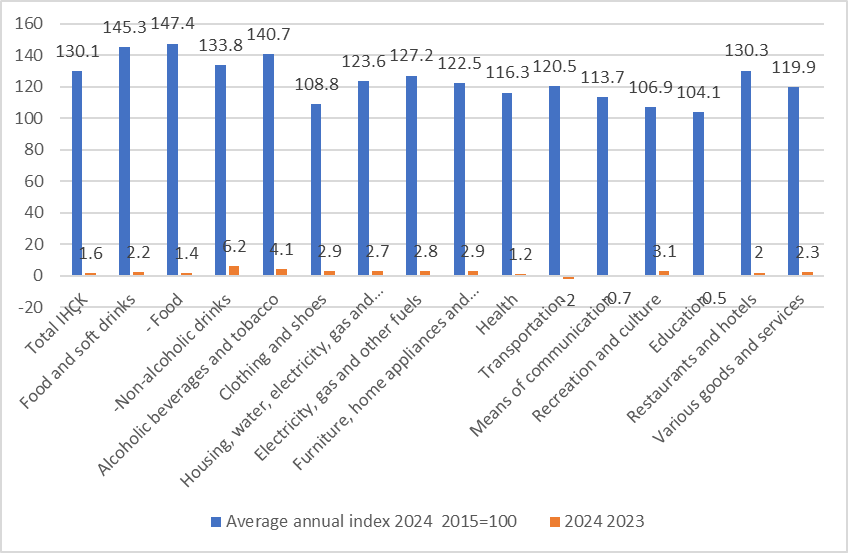
Figure 3: Weights, IHÇK for the month of December 2024 (2015=100), monthly and annual price changes for groups and subgroups according to COICOP
The table and graph show the trend of consumer price increases, where in most of the consumer basket, it is observed that there is progress in increasing consumer prices in 2024 compared to 2023. The table and graph show the trend of consumer price increases, where inflation increased in 2024 at an average annual rate of 1.6 percentage points compared to 2023.
Table 3: Average prices for some consumer goods and services -in euros
|
Code |
Items |
The measure |
XII 2023 |
XI 2024 |
XII 2024 |
|
101 |
Rice |
1 kg |
1.64 |
1.69 |
1.67 |
|
102 |
Wheat flour |
1 kg |
0.80 |
0.81 |
0.81 |
|
103 |
White bread |
500 gr |
0.51 |
0.52 |
0.51 |
|
111 |
Boneless beef |
1 kg |
8.88 |
8.98 |
9.02 |
|
112 |
Beef |
1 kg |
10.15 |
10.23 |
10.22 |
|
114 |
Chicken meat |
1 kg |
3.94 |
4.15 |
4.11 |
|
131 |
Milk (tetrapak) |
1 lit |
1.18 |
1.22 |
1.23 |
|
133 |
Yogurt |
1 lit |
1.15 |
1.21 |
1.20 |
|
137 |
Egg |
30 Pieces |
3.39 |
3.04 |
3.30 |
|
141 |
Edible sunflower oil |
1 lit |
1.40 |
1.48 |
1.52 |
|
151 |
Apple |
1 kg |
0.95 |
0.94 |
0.91 |
|
152 |
Pear |
1 kg |
1.93 |
1.89 |
1.88 |
|
153 |
Bananas |
1 kg |
1.43 |
1.38 |
1.38 |
|
155 |
Lemon |
1 kg |
1.31 |
1.60 |
1.50 |
|
161 |
Potato |
1 kg |
0.81 |
0.53 |
0.60 |
|
162 |
Tomato |
1 kg |
1.64 |
1.85 |
1.85 |
|
163 |
Legume |
1 kg |
3.31 |
3.62 |
3.68 |
|
167 |
Peppers without chili |
1 kg |
1.89 |
2.07 |
2.14 |
|
175 |
Sugar |
1 kg |
1.28 |
1.24 |
1.21 |
|
192 |
Ground coffee |
1 kg |
11.28 |
13.35 |
13.94 |
|
193 |
Tea |
1 kg |
9.08 |
9.29 |
9.29 |
|
195/1 |
Natural still water |
1.5 lit |
0.35 |
0.37 |
0.37 |
|
196 |
Coca cola |
2 lit |
1.46 |
1.57 |
1.58 |
|
197 |
Tree juice |
1 lit |
1.08 |
1.09 |
1.08 |
|
204 |
Beer |
0.5 lit |
0.82 |
0.86 |
0.86 |
|
216 |
Cigarettes-Ronson |
1 pako |
2.08 |
2.09 |
2.10 |
|
217 |
Cigarettes-Malboro |
1 pako |
3.06 |
3.09 |
3.10 |
|
416 |
Electricity (no fixed cost) |
1 kwh |
0.08 |
0.07 |
0.07 |
|
418 |
Fire wood |
1 m3 |
63.22 |
56.02 |
55.91 |
|
701 |
Gasoline |
1 lit |
1.29 |
1.27 |
1.26 |
|
702 |
Diesel |
1 lit |
1.34 |
1.24 |
1.23 |
Source: Kosovo Statistics Agency, Harmonized Index of Consumer Prices, Pristina, January, 2025, pg, 11.
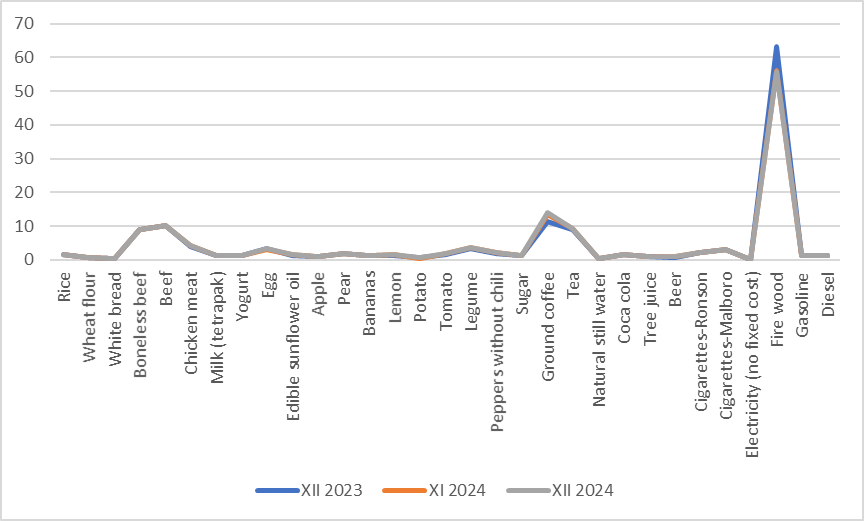
Figure 4: Average prices for some consumer goods and services
The table reflects the performance of average prices for several items and services included in the consumer price index for the period December 2024 compared to December 2023, where a slight increase, but also some stability of consumer prices in Kosovo for the reference period, is observed.
Economic growth is considered one of the main macroeconomic objectives. This is due to the fact that economic growth is closely related to the standard of living of the population of a country. The increase in the standard of living of the population comes as a result of the increase in the production of goods and services. An important indicator of the standard of living of the population is the production per capita of the population.
The improvement of the standard of living of the population of a country comes when each individual over time has at his disposal more goods and services to consume than before. One of the most well-known indicators and which is followed with interest by all economic entities is inflation. Inflation is a serious problem that negatively affects both the reproduction process and the social stability of the country. Inflation as a macroeconomic phenomenon affects almost all layers of the population, that is, everyone who buys or sells goods and services. The basket of the Kosovar consumer is characterized by a fairly high participation of products that have seasonal price movements. This includes food, energy, alcoholic beverages and tobacco which make up about half of the consumer's basket. The prices of these products have determined the movement of the general price index during the past years not only because of the high participation they have in the consumption basket but also because the movement of these prices has been more pronounced. Basic inflation, which excludes the categories characterized by more significant price changes, presents a clearer overview of inflation in Kosovo.
Since Kosovo's economy is small and import-dependent, it is natural that tradable components of goods and services have a high participation in the CPI and, therefore, determine the movement of the general price level. Tradable components make up about 81.9 percent of the Kosovar consumer basket, while non-tradable components (mainly services) make up about 18.1 percent of the consumer basket. The prices of non-tradable goods and services have historically been more stable compared to the prices of tradable goods, with the exception of the last two years where the decline in the prices of non-tradable goods was more pronounced.
Any inflation that exceeds the growth rate of more than 3%, then passes to levels where the created situation must be monitored because it can pass to frightening levels that can ruin the country's economy. Usually to calculate the price level economists start with the concept of the consumer basket (which has several common products). The cost of living is directly affected by the increase in prices, and in connection with this, the consumer tends to buy less and always tries to find substitute products. The following table reflects the inflation trend in the countries of the Western Balkans.
Table 4: Consumer price index in Western Balkans in the period 2021-2024
|
Years |
2021 |
2022 |
2023 |
2024 |
|
Albania |
2 |
6.7 |
4.8 |
2.2 |
|
Bosnia and Herzegovina |
2 |
14 |
6.1 |
2 |
|
Kosovo |
3.3 |
11.6 |
4.9 |
2 |
|
Montenegro |
2.4 |
13 |
8.6 |
4.2 |
|
North Macedonia |
3.2 |
14.2 |
9.4 |
3.5 |
|
Serbia |
4 |
11.9 |
12.1 |
4.5 |
Source: World Bank Group, Western Balkans Regular Economic Report, No.26/Fall 2024, pg.93-109.
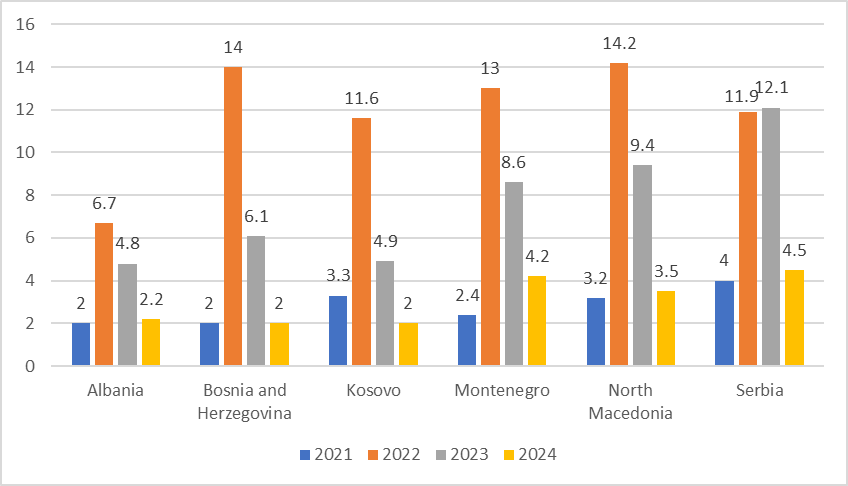
Figure 5: Consumer price index in Western Balkans in the period 2021-2024.
The table and graph present the inflation equation in the Western Balkan countries, where it is noted that in 2022 there was an increase in inflation where inflation reached double-digit rates in the Western Balkan countries, while in 2023 and 2024 inflation was at an average annual rate of 2% to 4%.
5.Conclusions
Inflation represents the continuous increase in general prices, where with a certain amount of money you can buy less products than before invalidation. Inflation indicates a decline in the purchasing power of a national economy, a reduction in domestic production and a dominance of external macroeconomic indicators, that in the case of Kosovo since the post-war period of 1999, the main indicator is the import that mercilessly hits the economy of Kosovo in the absence of local production capacities. Inflation hits all strata, but mostly those families where the monthly income is low or live on social assistance. Inflation is said to favor consumption in general, but in contrast to this favor, it reduces savings and even uses and spends previous savings. The reason for this is because confidence in money (its stability) is lost and everyone wants to be freed from money to buy even those goods that they probably don't need.
In general, the inflation in Kosovo in the previous years was normal, which means below 2 percent on an annual basis, while in 2021 with more pronounced growth trends, especially in 2022, reaching a double-digit inflation rate. Care should be taken regarding a careful macroeconomic governance regarding inflation, otherwise the situation may get out of control. In this regard, fiscal policy actions and measures must be taken (reduction of tax rates (VAT), tax relief) in the goods and services necessary for life, affecting the reduction of the prices of the goods and services of the consumer basket.
Acknowledgements
We sincerely thank everyone for their cooperation, including the staff of the Central Bank of Kosovo and the Statistical Agency of Kosovo, who were very professional and cooperative.